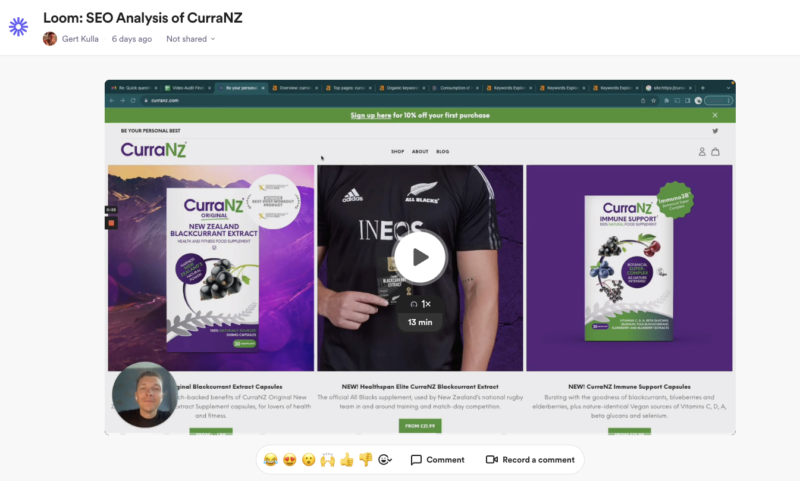Our core philosophy is to try and keep everything as simple as possible, while getting at least a 10-1 return on investment to the clients that trust us with their ecommerce SEO campaigns.
PS! I also have our entire E-commerce SEO process explained in the video below as well, if you prefer the video format:
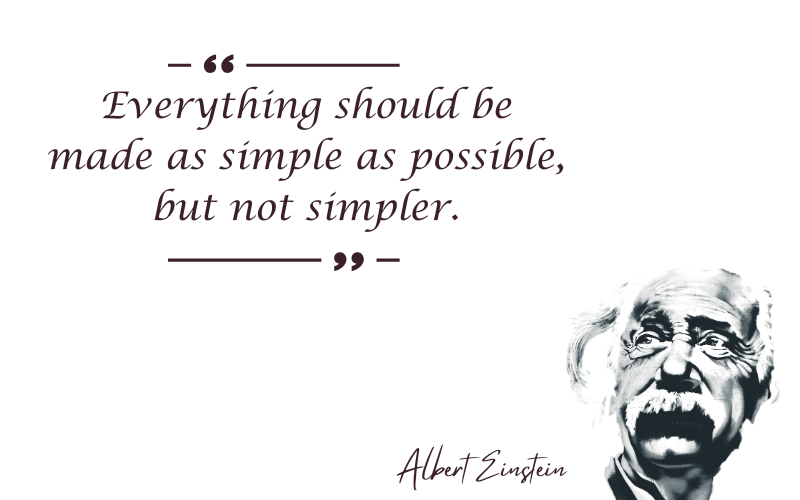
In order to keep our process as efficient as possible and to deliver maximum ROI for our clients, we continuously analyse and fine-tune our process based on the following:
Below you’ll find the complete overview of our current E-commerce SEO process.
We go through all of the steps mentioned. The first thing that we do is identify the gaps in different areas between you and the sites that are currently ranking in the top 3.
Once we know what you’re missing, we will fix all problems and start filling all the gaps to get you into the top 3 and help you dominate your industry.
How fast we’ll get there depends on the specific ecommerce SEO package you choose.
Why?
I guess you’ve heard the phrase, SEO takes time.. well, it does, unfortunately.

However, as I’m assuming you already have a website up and running, we can easily audit your site to find if there are any possible quick fixes that we could implement to immediately increase your traffic.
By starting from this, we will kickstart the progress and start getting you results ASAP.
How?
Our SEO strategist will check through your site and compare your current site to e-commerce SEO best-practices. If we see any major differences that we know hold back your rankings, we will help to get these fixed.
Also, we will identify if there are any search terms where you are close to the top 3, but not quite there yet. In these cases, all you need is 1-2 backlinks.
Building these links might 5-10x your organic traffic to that particular page.
Why?
Technical SEO errors can be holding back your site from reaching its’ full potential. Also, the amount of errors on a site correlates negatively with Google rankings.
We just want to make sure that all the work that you’ve done so far and all the work we will be doing in the future will have a maximum effect. Finding and fixing all technical errors will allow us to do just that.
How?
We will run a full website crawl with two crawler tools – Ahrefs and Screaming Frog.
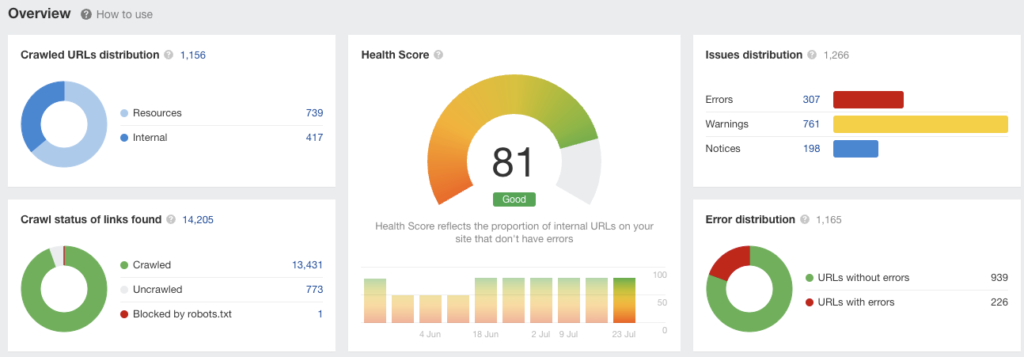
The tools will give us a list of all possible SEO issues that your site is having. All issues are listed based on order of importance.
We will prioritise fixing all the issues in order of importance and work our way down the list.
In addition to running this process in the beginning of a campaign, we will run a new crawl periodically, every few months to fix all future issues that might come up.
Why?
In order to know what are the search terms we should optimise your pages for, we first need to know the main keywords that people use to find the products that you are selling.
EXAMPLE 1:
Let’s say that you’re selling coffee beans and you’d like to get some more organic traffic to your decaf coffee beans page.
In this example, which of the keywords should you optimise your page to target?
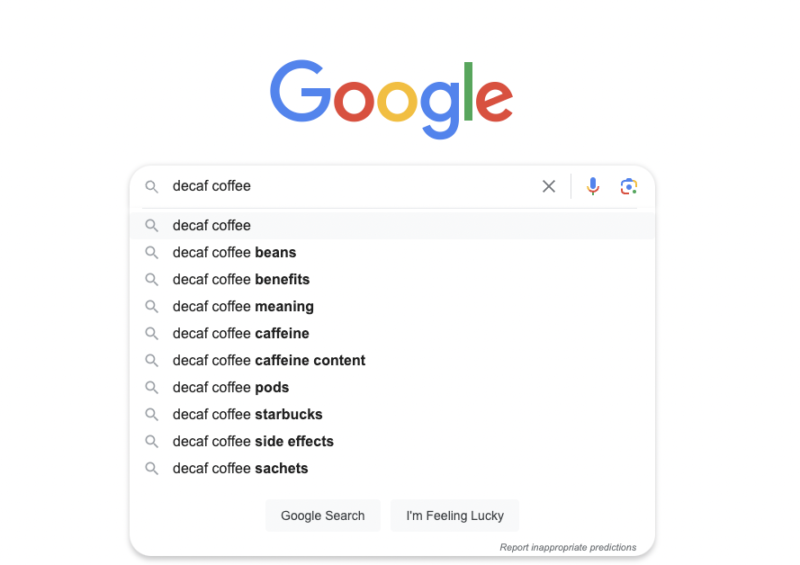
a. “decaf coffee”
or
b. “decaffeinated coffee”
EXAMPLE 2
Another question you might have is that do people mainly search for “decaf coffee” or “decaf coffee beans”?
The keyword research process gives answers to the following questions:
The keyword research part is the most important part of an SEO process.
Good keyword research will help you achieve incredible results without having to spend too much on backlinks.
How?
#1 – Which keyword has the most search volume
The first step in our keyword research process is to analyse your existing pages to understand if you’re targeting the right keywords.
In order to research this, we use Ahrefs. Below you’ll find a list of the keywords we discussed earlier.
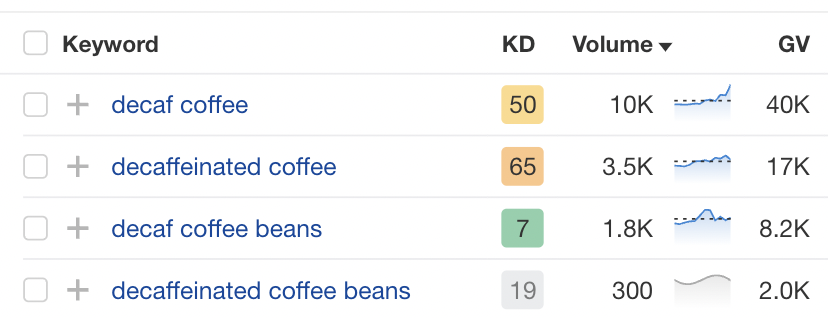
Volume – The keywords’ monthly search volume in the US
KD – how difficult it is to rank for this term on a scale of 0-100
GV – global monthly search volume of the keyword
From here we could already find answers to our first question, which was – should you target the term “decaf coffee” or “decaffeinated coffee”. It appears that people are too lazy to type in the full word, so they use “decaf” 3 times more often.
#2 – Which keyword has the right search intent
This is a bit trickier to analyse, but what it means is that we need to understand what is the intent of the people searching for that term.
Someone searching for “decaf coffee” might not be interested to buy it, but they are rather just looking for what it is and how it’s made. In this case, it wouldn’t make sense to optimise our page to target this keyword.
In order to understand the intent, we simply need to look at which sites Google is currently showing as the top results for a given search term.
Here are the top results for the keyword “decaf coffee”
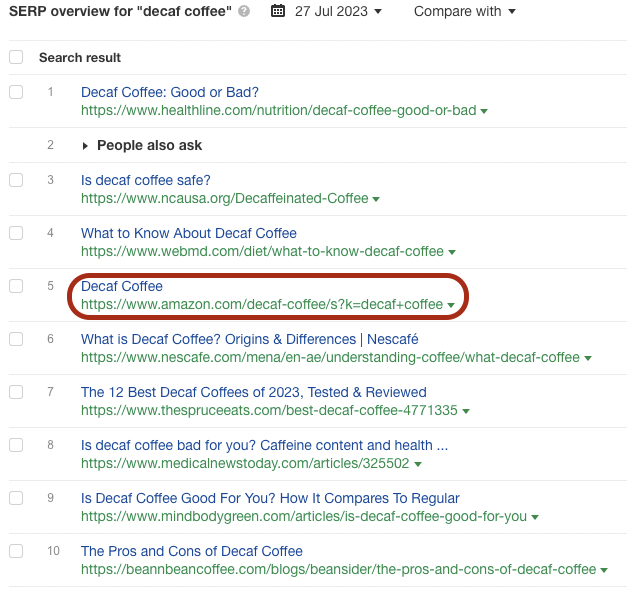
If you can notice, only one result on the first page is a page that sells decaf coffee beans. All others are blog articles.
So in this case, it wouldn’t make sense to optimise your category page to rank for this particular term. Instead, you could also write blog articles about this topic and target the keyword with blog content instead.
In this part of the process, we’re mainly interested in optimising your most important / profitable pages, which are your product and category pages.
Now, if we look at the keyword “decaf coffee beans”, here’s what we’ll see:
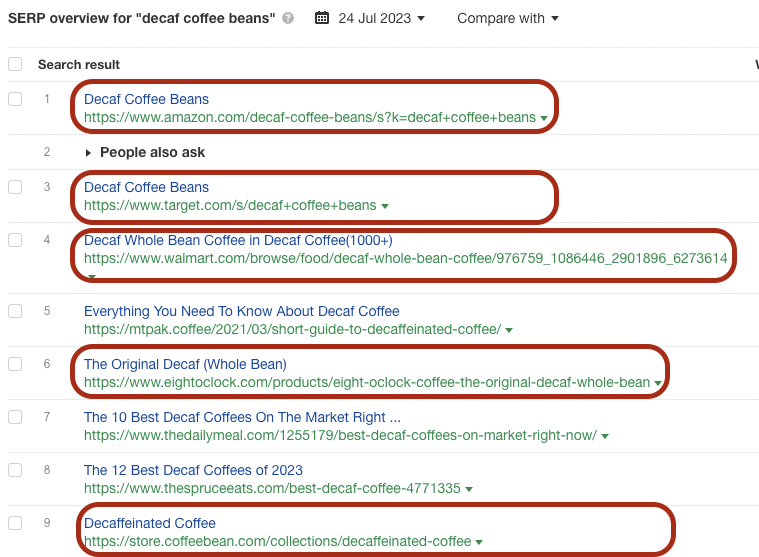
Most search results are actual product or category pages.
Based on this, we need to optimise your decaf coffee beans collection/category page for the keyword “decaf coffee beans”.
PS! If you noticed, Amazon, Target and Walmart are dominating this search result in the USA. This is where get very excited as we love a good challenge.
What I mean here is that we love to tackle these David vs Goliath situations and help our clients outrank Amazon and all other behemoths.
#3 – Is this the best possible keyword to use?
One more important check that we do is that we look at the current top rankers and look at all the keywords that they rank for with that particular page.
We then look at which of those keywords has the best search volume and difficulty ratio.
In this case, we open up Target.com’s decaf coffee beans page to see all the keywords that it is ranking for and sort the keywords based on which has the most search volume:
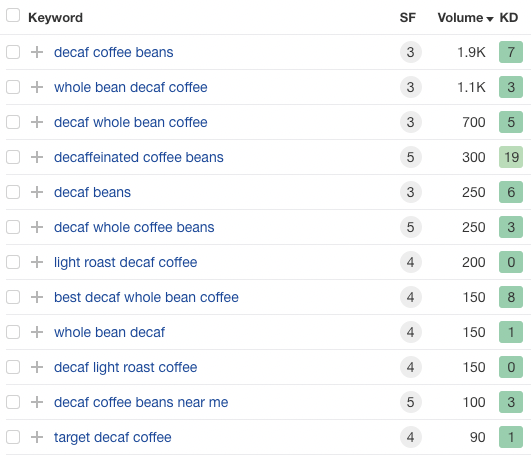
In this case, we see that the term that we already found “decaf coffee beans” is the best possible keyword.
Often times we find that there are other variations of the keyword that we haven’t even thought about that have much more search volume.
PS! We also use this list to come up with backlink anchors to use when building out internal and external backlinks, but more on those below.
We repeat the same process for all of your main products and categories.
As I said, it is super important and you don’t want to miss this step when doing SEO for yourself.
Moving on..
Why?
Once we identify all the main keywords that each of your product and category pages should target, we now need to make sure that all your pages are optimised as best as possible.
The better your on-page optimisation, the less backlinks you need to build to rank for a given search term.
How?
For this part, we use SurferSEO.
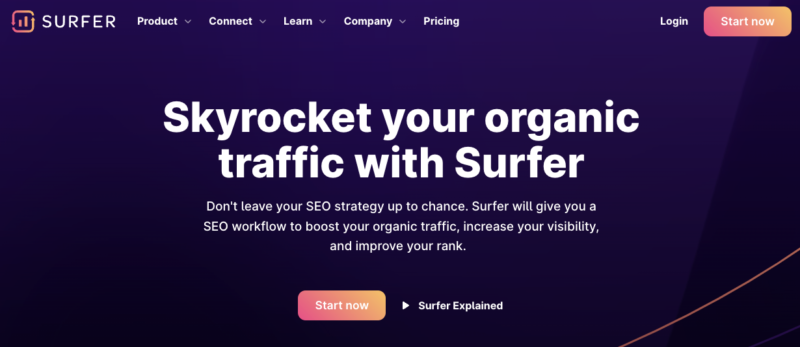
This is an SEO tool that looks at the current top rankers, analyses which keywords, phrases and subtopics they have covered on their pages and which of these correlate to the highest rankings.
It then gives us recommendations on how to improve our page.
EXAMPLE:
If we take Mayorgacoffee.com, who are currently ranking in position #30 for the keyword #decaf coffee beans”, we see that they’re currently getting 20 organic visitors from Google per month.

In comparison, the top rankers received over 1K from the US alone and roughly 5-8K internationally.
Think of the difference it would make to Mayorgacoffee.com’s business if they were to get into the top 3.
For the onpage analysis, we simply add them to the SurferSEO analysis tool:
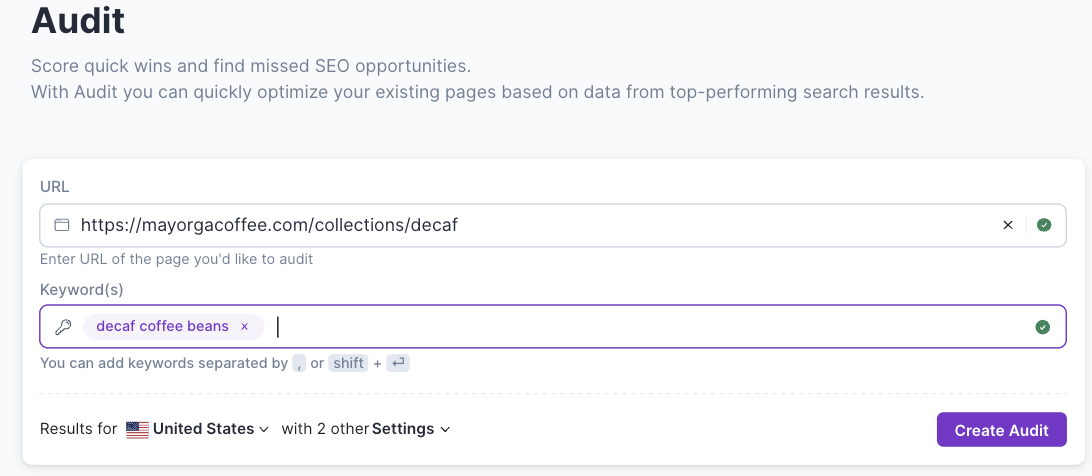
And we get back a full analysis of different aspects to improve.
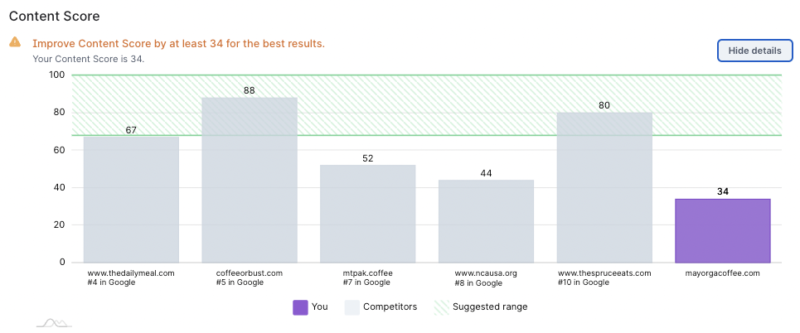
We see that Mayorgocoffee’s content score is only a 34, while the average for the first page is around 70.
This means that we need to tweak the keywords and add some content to the page.
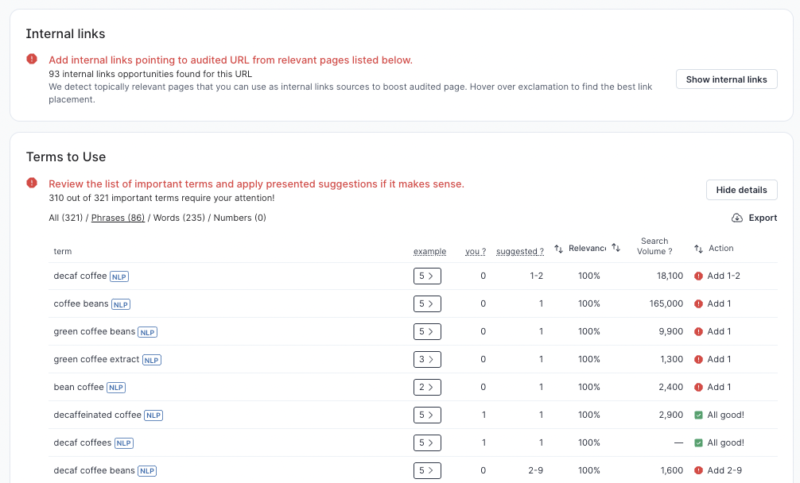
Surfer also tells us that we’d need to add a lot of internal links (links from other pages on your own website) to help the page rank higher.
Also, we get a big list of keywords to add/optimise on the page as you can see on the image above.
This is a lot of work that we’ve trained our staff to handle to make sure that our clients’ websites are optimised better than everything else that’s out there.
Why?
In more cases than not, we find that the client is lacking important category or product pages. Creating those pages is rather simple and can yield outsized benefits.
When we first analyse a site and do keyword research, we also look at all the products that the client is currently selling to make sure that they have created all pages that need to be created.
At first glance, this might seem obvious to you and you might ask, what could we possibly find that the client hasn’t made a product or a service page for?
The above example of decaf coffee was actually taken from one such case.
Our client sold coffee beans locally in their country and they were also selling decaf coffee beans. Yes, they did have a few different product pages listing different decaf coffee beans, but they didn’t have a category page for “decaf coffee beans”.
They were ranking in position #85 for the keyword “decaf coffee beans” with one of their product pages. But ranking with a product page for this type of keyword is far from optimal.
PS! Not having dedicated category pages for different product categories is one of the mistakes we see most often with E-commerce store. Fixing this is an easy task that will yield significant results.
Once we created a dedicated category page for them, they started ranking in position #13 without doing anything else.
If you only rank with a product page and if you have more than one product within the category, Google doesn’t know which page to rank for that keyword and ends up ranking none of them.
Category pages list different products and gain natural internal links and power from the products within the category itself.
Also, if your competitors have a category page and you do not, you’re giving them an unfair advantage. You don’t want to do that.
How?
To find these missing pages, we use many different strategies.
#1 Analyse your competitors
The first step in the process is to analyse your competitors and see which product and category pages are bringing them traffic that we also sell, but don’t currently have a dedicated page for.
You can search around on your competitors’ websites to find pages like that.
Or, if you’d like to shortcut the process, you can simply add your competitors to Ahrefs content gap analysis and look for keywords that they rank for that you do not.
This is what we’ve done for the Mayorgacoffee.com’s website below:
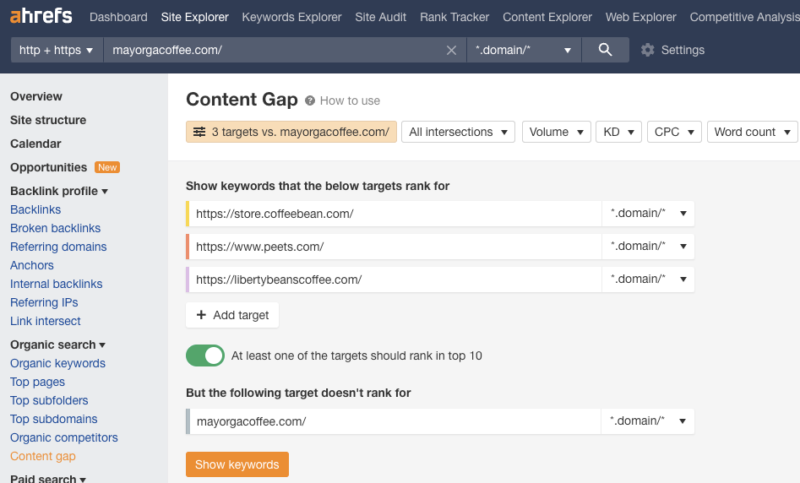
By plugging in just 3 competitors, we got back a list of over 2,000 keywords.
Here I’ve highlighted some of the keywords that I’d be interested to research more:
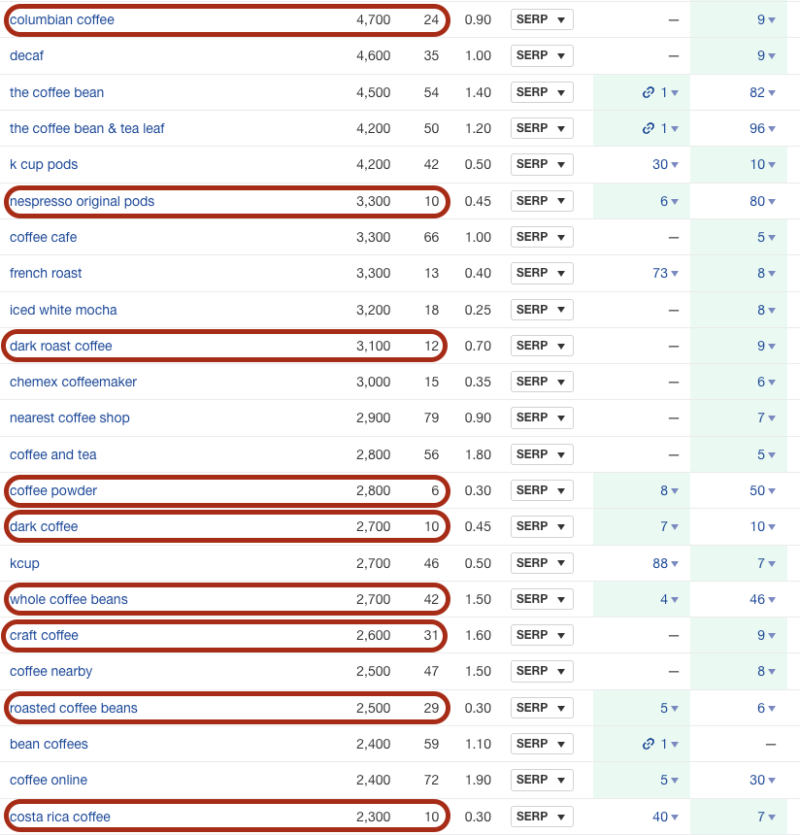
These are all keywords that Mayo doesn’t already rank for – so they probably don’t have a dedicated page for these or they’re poorly optimised.
Whatever the case, we can fix that.
Also, we like to start this process by going after the keywords that our weaker competitors are ranking for, because then we know it’s easy for us to beat them once we simply create a page to target that keyword.
By weaker I mean newer websites with less authority than ours.
#2 – Analysing your current keywords
This process involves looking at the keywords your products are ranking for, where a category page would be needed.
Here again, you’ll need an SEO tool to do this research.
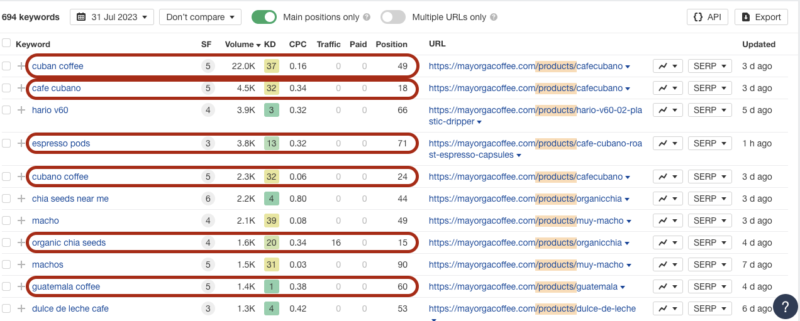
If we look for all the keywords that Mayorga is ranking for with their product pages, we find a number of “gold nuggets” here.
If this was my business, I’d be super excited.
Why?
They are ranking in position #18 for the keyword “Cafe Cubano” with a simple product page. If they’d simply create a category page here, they’d rank much higher.
Also, it would only need a little optimisation and a few links, but the traffic potential is huge.
The same goes for “espresso pods”, “guatemala coffee” and “organic chia seeds” where the difficulty to rank is very low.
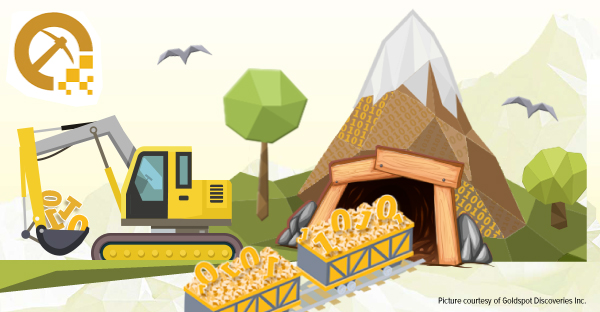
Finding a good keyword is like finding gold – you stand to add a good amount of additional traffic, sales and profits through that.
PS! This is one of the most impactful SEO activities that you can do. I recommend you go through this process for yourself or have someone do this for you.
PPS! A few parts of this are also included in our free video analysis.
Why?
Once we know what keywords you should target, matched the right pages with the right keywords and have fully optimised all of the pages, the only thing that is missing from getting to the top 3 is backlinks.
Backlinks are hyperlinks from other websites (see example from Forbes.com below).
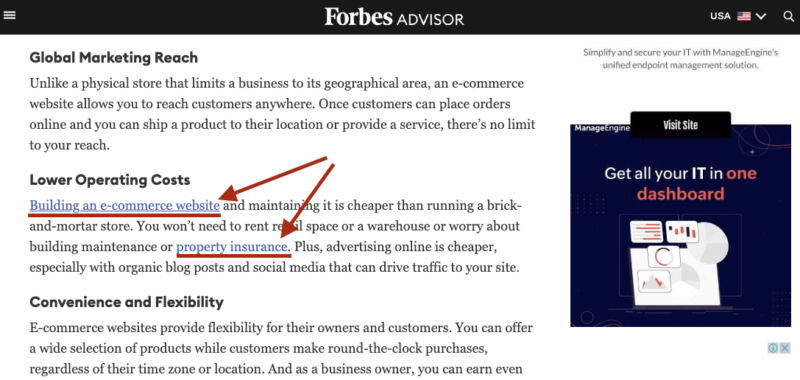
Google’s algorithm is based on ranking websites based on how many backlinks they have from other websites.
As said above, backlinks are also the main determining factor for rankings when your website is already well optimised.
Also, you can outrank your competitors with backlinks in most cases, even if your page isn’t that well optimised. It’s just more expensive to build backlinks than it is to optimise your pages.
Because quality backlinks are expensive, it is important to first analyse how many you need to build and which pages would benefit the most.
How?
We have a full article on link building for ecommerce. So I’m not going to explain how to build backlinks here, but I strongly advise that you read through the article if you’re serious about getting to the top 3 for any keyword in your niche.
Why?
In most cases, our clients have already done a few, if not hundreds of blog articles by themselves.
Unfortunately, most of those blog articles aren’t ranking or bringing in any organic traffic.
You have spent resources to craft these articles, so what we do is list all articles and start optimising them similarly to how we optimise the product and category pages.
As blog articles take longer to optimise, we will ask our clients for which articles are the most important for them to only work on the pages that have high odds of bringing in actual customers.
If done correctly, your blog articles can bring you new visitors that will read your content, get to know your brand, start to trust you and potentially make a purchase with you.
If we follow with our example Mayorgacoffee.com, we see that they’ve done over 232 blog articles, but 15 of those pages are getting any significant traffic:
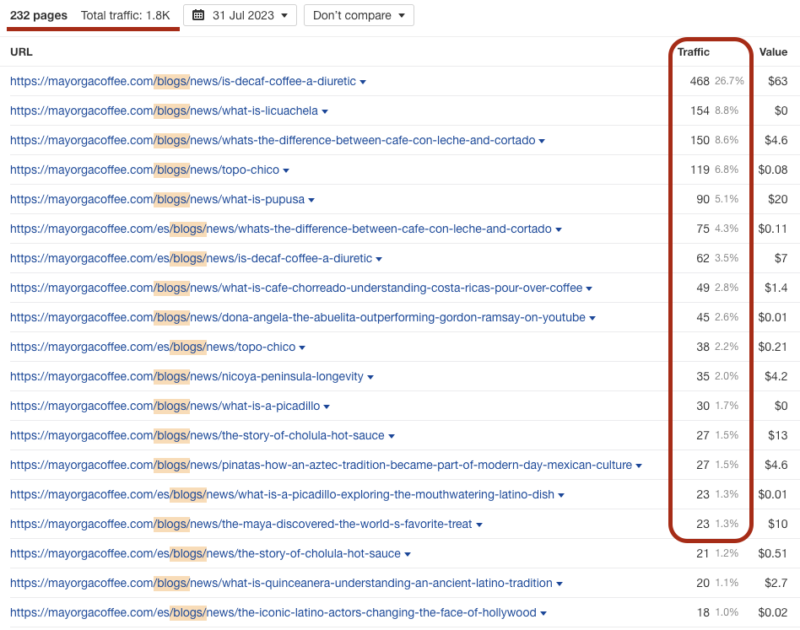
If we estimate that they’ve spend an average of $100 per blog article (this is very conservative), that means they’ve spent $23,200 on blog articles. We see that these blog articles are getting them 1,800 visitors per month.
This isn’t too bad, but there are about 210 articles that get little to no traffic at all.
How?
We list out all articles, analyse if they already do or have the potential to target a specific keyword that people are searching for.
We then check through all articles and assign importance based on how likely we believe the article to be to convert readers into visitors.
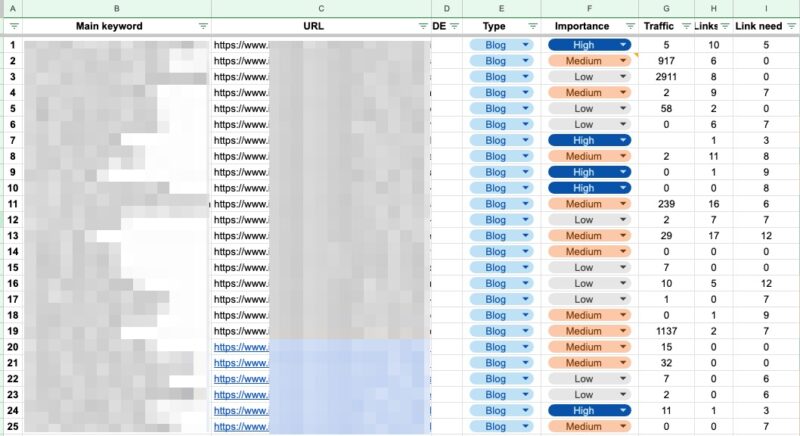
This list is then sent to our client for approval. After the client has sent us back their list of articles, they deem important, we start optimising the articles.
The optimisation process is the same for blog articles as already described above for product and category pages.
Why?
Blog articles serve two important purposes:
1. They bring in your target customers
This is achieved through answering their questions or educating them about topics related to your products.
As mentioned above, this will help to build trust, gain brand recognition and convert some of the readers into buyers or at least have the ability to remarket to them via retargeting campaigns or through email marketing.
2. They help your main category and product pages to rank higher.
If you want to rank for the keyword “decaf coffee beans”, having 5 different blog articles that talk about the benefits, the production process, different types of decaf beans and internally linking from those articles to the main category or product pages will give you a significant ranking boost.
Five blog articles is just an arbitrary number. Usually, we start out from doing 3 at minimum, but we want to make sure that we have more than your competitors.
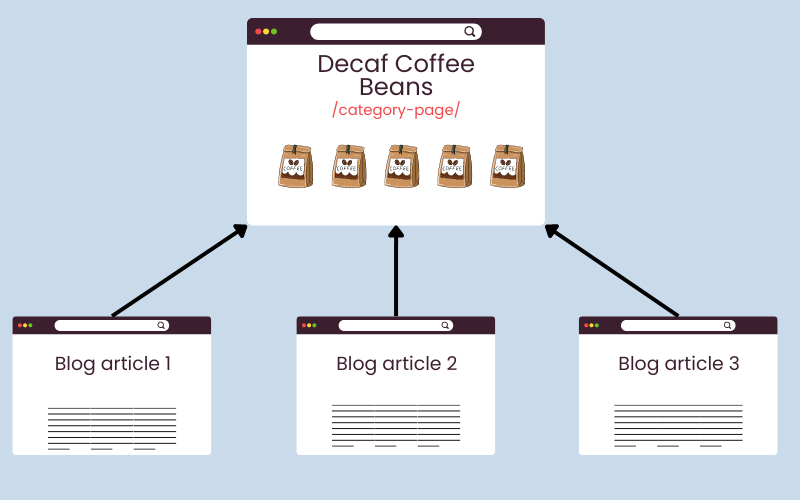
How?
#1 Analyse your competitors blogs
Your competitors have already done some of the heavy lifting for you. Using some SEO tools, we can look at what blog articles are bringing traffic to your competitors that you don’t already have.
If these keywords are also commercially attractive for you to target, we create blog articles on the same topics while focusing on making our articles better and more in-depth.
Here’s an example of the Mayorgacoffee again:
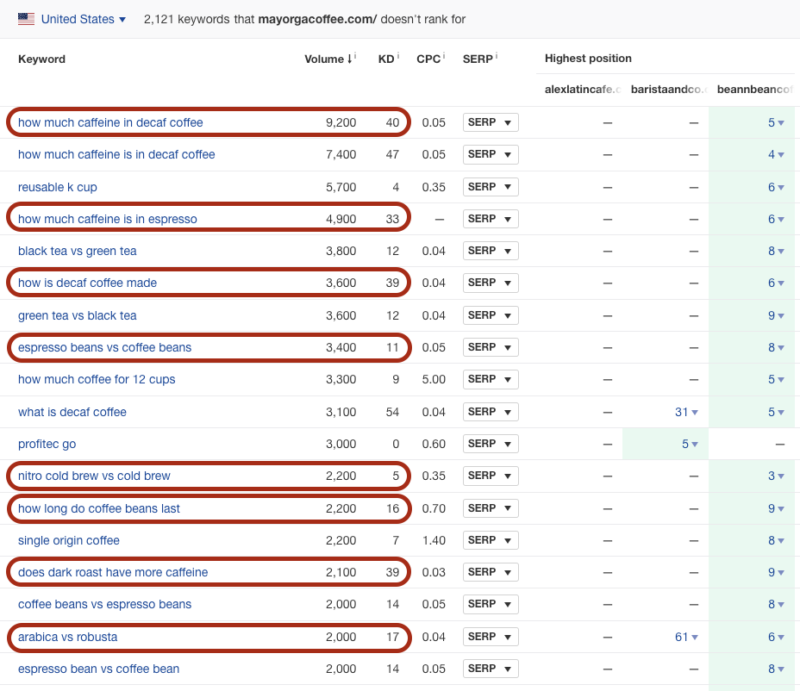 I’ve highlighted some of the keywords that would fit well to be made into blog articles.
I’ve highlighted some of the keywords that would fit well to be made into blog articles.
These are all keywords that are competitors are ranking in the top 10, but Mayo isn’t even in the top 100.
So they don’t have pages targeting those keywords yet.
Once we have a good list of potential article topics ready, we will share the list with a client for them to confirm, after which we produce the articles.
PS! Doing this type of keyword research will ensure that we will only create blog articles that people are actually searching for.
Once you rank for these keywords, you will gain organic traffic from Google, consistently, every month.
#2 Look at the questions people are asking related to your niche
To do that, we can type in a broad niche-related keyword into a keyword research tool and look for all related questions that people have.
So I typed in “coffee” and filtered for questions:
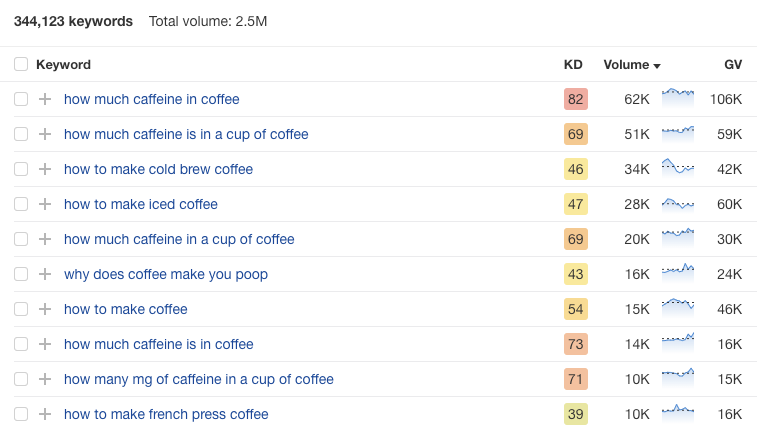
My tool found over 344,000 keywords with a total search volume of 2,5 million. And this is only in the United States.
If you noticed, the keyword difficulty (KD) is rather high, so I’d filter the list to only show KD of up to 10, to only see keywords where it’s rather easy to rank.
Also, if we do this for the keyword “decaf coffee” to find relevant blog ideas for our example, here are the first results I found:
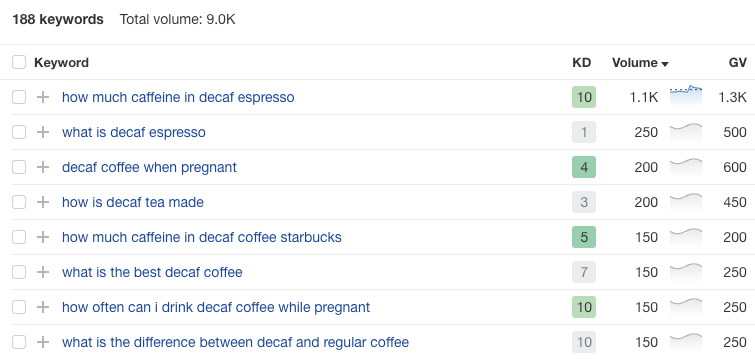
With a total of 188 keyword ideas, it’s rather easy to find 3-5 to start out with.
Why?
Internal links are easy to build, if you know what you’re doing and they are effective in helping you rank higher.

SEO is the same way..
You don’t need to have 100 percent optimisation and all the links you could possibly acquire. All you need is to have a better optimised website and more links than your competitors.
Building out internal links is a tedious task that needs precision, some skill and time.
Most of your competitors don’t know how or don’t bother to build internal links, which will give you a competitive advantage, if you do.
This is something we do for all our clients, mainly because the return on investment is worth it.
Also, with internal links, you can “tell Google” what the page you’re linking to is about.
Remember the list of keywords we found earlier that showed a list of keywords Target.com’s decaf page was ranking for?
Here it is again for you:

If you simply take those keywords and use them as anchor text when linking from one page on your site to another, you will have much higher odds of ranking higher for all of those terms with just one page.
So if you’d want to create internal links from your blog pages about decaf coffee, use these specific terms as anchor text when linking to your decaf category page.
How?
There are many different methods to find internal link opportunities. Here are two methods that don’t require you to have access to any of the tools:
#1 Link to the category page from all product pages
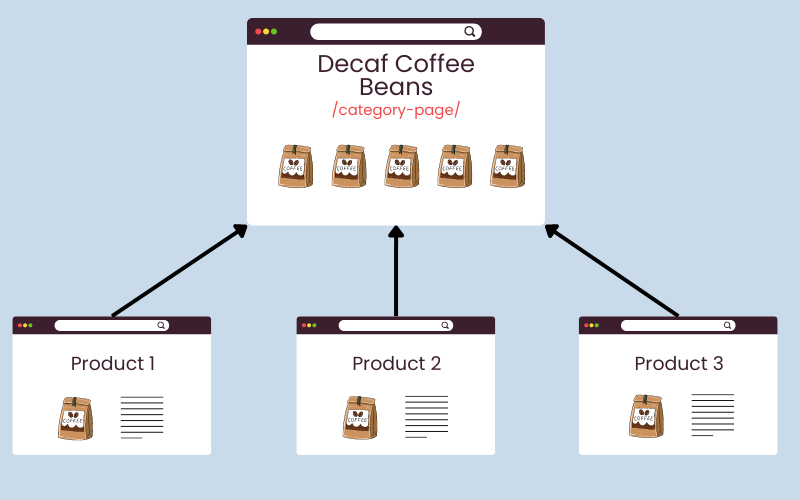
Also, try to use the main keyword of the category as anchor text or a close variation of it. The best place to link out from would be from the product description or somewhere near the top of the page.
If you have hundreds of products in a category, no need to add internal links from all of them. 10-20 will suffice.
#2 Do a site:website.com keyword search
For the Mayo site, we would put this into Google

What it does is it looks for all content on your website that is relevant to the page you’re trying to build internal links to.
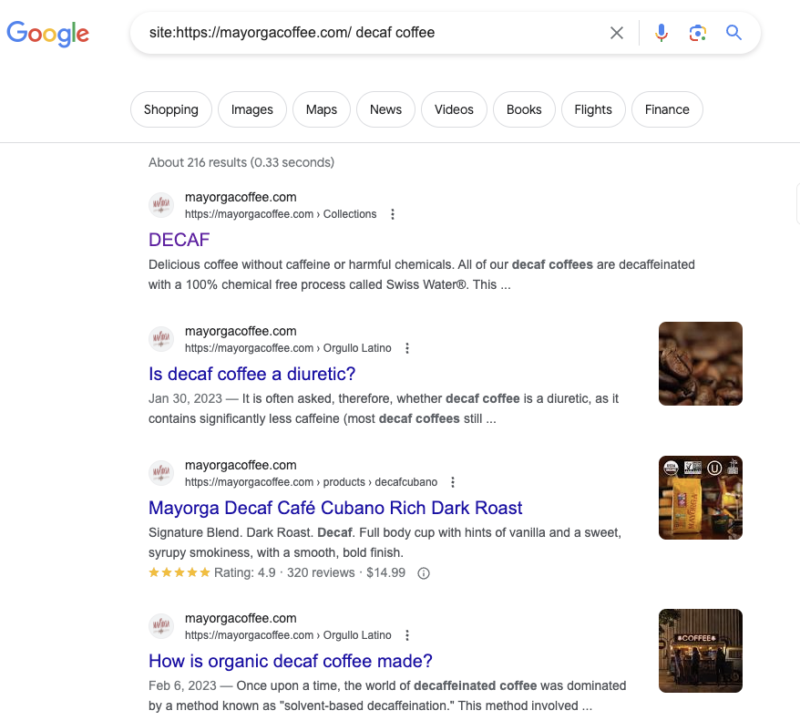
From here, you would simply open up the pages one-by-one and look if you’re able to find a natural place to add an internal link to.
I’d recommend to build at least 10 of these. The more competitive the search term, the more I’d build.
Why?
We do this for two main reasons:
1. We want to know what is the effect from all the work we’re doing.
As we do this for all projects we’re working on, it helps to educate us in terms of what’s working and what is not.
Our #1 goal is to make you (a lot) more money than what you pay us. So we need to keep track of how we’re doing.
If we see that our efforts aren’t working, we will let you know immediately so that we can either adjust or stop working together. This rarely happens, but when it does, we are 100% transparent with you and will notify you immediately.
We can then discuss if we should switch strategy (e.g. build more links and less content or vice versa), increase/decrease budget or discontinue working together.
2. To inform you of the progress and what we’ve done.
SEO is a black box for most clients. They just order a service and hope for the best.
We want you to know about all the tasks we’ve done, are currently doing, and are planning to do.
You are always welcome to ask us questions or have a say at what we’re doing.
How?
We analyse the results using Google Search Console, Google Analytics, Ahrefs and a few additional tools.
The results of our analysis are sent to you via email with our comments and executive summary.
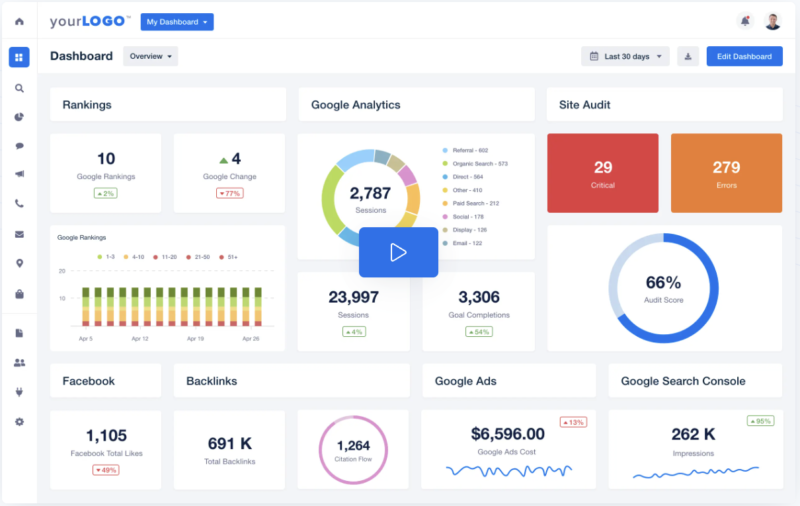
We also send you ad-hoc video overviews and progress updates in case of any significant wins or milestone achievements.
